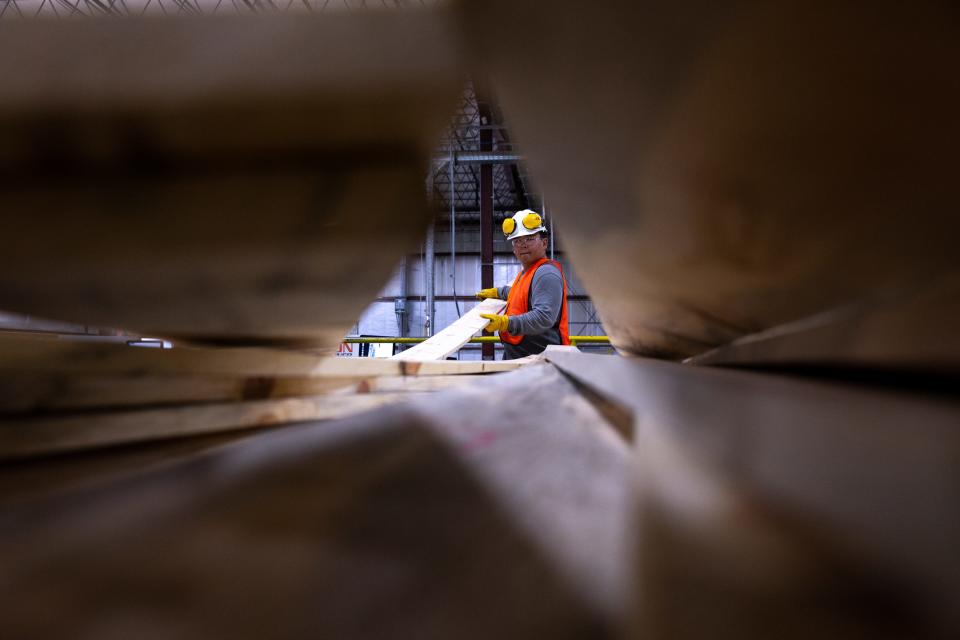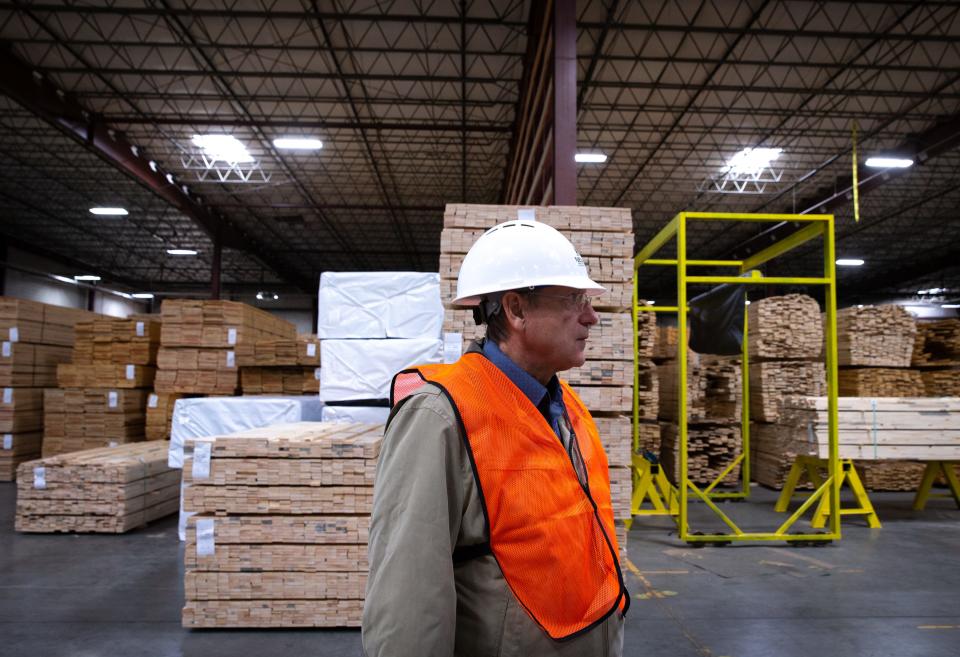Arizona lumber mill struggles to pay interest on $200 million in bonds
The plan was ambitious and sold as righteous in a time of increasing wildfires in the forests of northern Arizona: A mill working under a federal contract would clear out small trees, removing them as potential wildfire fuel, and turning them into usable lumber.
The company with those plans, NewLife Forest Restoration, received help in building the mill from a relatively obscure state agency, the Arizona Industrial Development Authority. In February 2022, the authority authorized the issuance of nearly $200 million worth of bonds for the project.
But the sawmill has run into financial trouble, making it at least the sixth project backed by the Arizona Industrial Development Authority that has reported trouble meeting its obligations to investors.
This project was in forbearance, meaning it had worked out a deal with its investors ahead of its missing payment. The deal avoids a default on the deal, a step towards a foreclosure that could seize the assets.
Four of the other troubled Arizona authority projects were in default and one was in forbearance.
AzIDA Bonds in Default | Dollar Amount | Description of Bonds |
Legacy Cares Inc. | $283,195,000 | Build and manage a 320-acre youth sports park and entertainment complex in Mesa, Arizona. |
Provident Group - Eastern Michigan University Parking | $36,065,000 | Build and manage a parking garage near the Eastern Michigan University commuter campus in Ypsilanti, Michigan. |
Elevate Housing Foundation - Illinois and Indiana | $31,180,000 | Purchase and manage three senior living complexes in Illinois and Indiana. |
Harvest Gold Silica | $22,040,000 | Turn mounds of sandy waste at a dormant goldmine in Congress, Arizona, into silica-based plant food. |
AzIDA Bonds in Forbearance | ||
Great Lakes Senior Living Communities LLC | $402,300,000 | Purchase and manage eight senior living complexes in Michigan and Ohio. |
New Life Forest Restoration | $200,000,000 | Expand NewLife's wood products manufacturing facilities and forest restoration capacity. |
The most high-profile default is Legacy Park, the massive complex of athletic fields and courts built in east Mesa. That project has filed for bankruptcy. And an attorney for the government trustee overseeing the case has raised the possibility that the principals involved misappropriated money or committed fraud.
The federal government allowed the creation of bonding authorities as a way for communities to give a helping hand to needed projects. Most authorities, such as those operated by the city of Phoenix and Maricopa County, use that bonding power to aid affordable housing and senior living projects. The break comes in the form of lower interest rates for the project.
Arizona’s authority has approved aiding more exotic projects, some of which were located out of state: road improvements around a power center in Idaho, a Hilton Garden Inn in Texas and a resort in Puerto Rico.
Gov. Katie Hobbs, who took office in January, has since asked the authority to concentrate on projects that more directly benefit the state, including those that deal with sustainability.
Measured against that, the sawmill would fit the bill.
However, the project has had fits and starts as part of a decade-long plan by the U.S. Forest Service to thin out small pine trees with the aim of avoiding catastrophic wildfires.

In September 2021, the U.S. Forest Service stopped the bidding process for a second phase of its Four Forest Restoration Initiative, which has failed to meet expectations. Officials at the time said they needed time to reassess what should be in future bids. And no word has followed on the future of the program.
Some environmental experts have advocated that small-growth trees and brush be simply set ablaze, as it would be quicker than awaiting a timber industry to rebuild itself in northern Arizona.
Yet, those behind the proposed sawmill in Bellemont are pressing on, with continued support from the Arizona Industrial Development Authority.
At its June meeting of the authority board, the company that owns the sawmill reported that it entered into an agreement with investors that would allow it to miss its scheduled interest payments. It also asked permission to go into debt by $50 million more to complete construction.
The authority unanimously approved.

According to the minutes of the meeting, Ted Dergousoff, the CEO of the company, blamed the delay in building the sawmill on supply chain issues, scheduling delays and inflation.
An attorney for the bond trustee, Bryant Barber, said the holders of the bonds had not only approved the additional debt but were providing direction on the project. Barber, according to the minutes of the meeting, said the investors were ready to invest more in the project so it could be completed.
The company changed its name to Restoration Forest Products in November and announced changes to its management team. It is the third name for the company that was originally known as Good Earth Power before it changed to NewLife Forest Restoration.
It was under the NewLife name that it won approval from the authority to receive the bond funding that would help it construct and equip a sawmill in Bellemont, just west of Flagstaff in northern Arizona.
The bonds allowed it to convert an already existing loan into one covered by government-issued bonds. According to documents filed with the prospectus, NewLife would shave at least 3% off its interest rate under the deal.
No one from Restoration Forest Products returned a request for comment.
Neither did anyone from Lateral Investment Management, who had invested more than $100 million in the company since 2017, the bond prospectus said.
Although the company has had the contract to thin the forests since September 2013, it had only completed about 15,000 acres of work by 2021.
Under its Good Earth name, the company was sued by the company it had hired to run its forest program. The lawsuit accused Good Earth of breaching its contract by not paying some $3 million in fees.
The lawsuit, which was filed in 2015, was settled in late 2016 with Good Earth agreeing to pay an undisclosed sum.
The project came before the Arizona Industrial Development Authority board three times, once for initial approval and two subsequent times for amendments and extensions.
The third time was in January 2022, months after the U.S. Forest Service stopped taking bids on the next phase of the Four Forests Restoration Project.
Still, the prospectus issued to potential investors in February 2022 said even if the federal program stopped, there was enough potential timber in the forest to meet the sawmill’s revenue projections.
The prospectus also contained a consultant’s report that described the sawmill’s plan as “ambitious.”
Its target rate of clearance would be a 600% increase over what it had historically accomplished. And its plan to create lumber from felled logs from the restoration area would be a 1,500% increase over past performance.
Besides Legacy Park, at least three other Arizona Industrial Development Authority projects have fallen into default.
One involved a parking garage at Eastern Michigan University in Ypsilanti, Michigan. Another is a collection of senior living homes in Illinois and Indiana.
The fourth is Harvest Gold, a company that converted mine trailings from an abandoned gold mine into plant food in the ghost town of Congress, Arizona. Its initial business plan was to sift through the waste to find gold flecks. In brochures, investors were told they had the option of receiving their payments in gold bars.
This article originally appeared on Arizona Republic: Arizona lumber mill struggles to pay interest on $200 million in bonds

